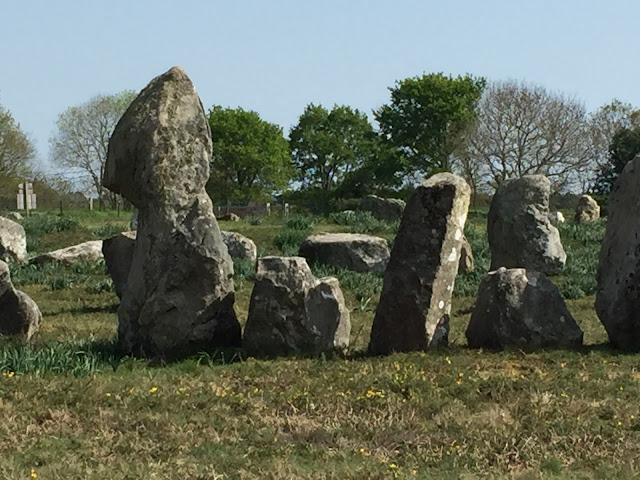Here are a couple of aerial views of portions of the stone alignments: from way above and closer in. And here's a video that puts together aerial views of many alignments in Brittany. (Ignore the creepy music at the start; it soon quiets down. There's no narration.)
Of course standing amongst the stones, one doesn't get such an overview. Instead, there is a feeling of immersion in a massive enterprise.
You can see the overall plan of the 3 major alignments here, and some additional photos here. [Added 8-25-25: And here's a video with great aerial views of the alignments in Brittany.]
My initial response was a sense of awe at the enormity of the human project, which must have required persistence over many years. There had to be a collective commitment to an endeavor that would eventually result in the lines of stones and the corridors in between them. This was my starting place: that the stones were a kind of witness to the persistence of humans, creating together a monument of deep meaning to them. So, the first words I had in mind as I thought about a possible art work in response to the alignments were "persistence" and "witness," and I have one piece sketched out that is centered on this theme. (More about that in a subsequent post.)
But I was also driven to find out what I could about the possible meaning of these lines of stones to the neolithic people who placed them. From the museum in Carnac and from early reading, it quickly became clear that there will never be a consensus on the issue of meaning. Archaeoastronomical explanations (e.g. connection to a solstice) don't work for these configurations, and of course there is no written record to refer to. I've been driven to do a fair amount of reading in the scholarship on these and other neolithic sites--a practice of reading and note-taking that I thought I'd left behind when I stopped doing historical scholarship in 2004. But here I am again, trying to piece together what some human actions meant, based on whatever evidence one could find--in this case physical evidence rather than written.
I am still reading and thinking about this, but it now makes sense to me that the overarching meaning of the alignments, taken together with other kinds of contemporary monuments in the same area--dolmens (stone tombs) and tumuli (burial mounds)--is connected to death and remembrance. That the manipulation of stone and earth (the stones "planted" in the earth, and earth mounded over stones) is an elemental response to human loss. (There are no burials associated with the menhirs, but the location of the lines of menhirs in relationship to the dolmens and tumuli puts the overall complex in close relationship to death and its associated emotions and practices.)
So. . . this brings me back to familiar territory, as a significant part of my previous work on loss was centered on stone, described here. I am in the midst of sketching out a second piece on the alignments that centers on this theme. I'll also write more about this in a later post.






Very interesting! Are you planning to use only grays for the quilt?
ReplyDeleteI'm still in progress on the palette. Stay tuned!
Delete